
Orbea lutea Photo by: Frikkie Hall
Origin and Habitat: South Africa (Free State, Gauteng, KwaZulu-Natal, Limpopo, Mpumalanga, Northern Cape, North West) Zimbabwe & Southern Mozambique
Altitude range: 500–1500 metres above sea level.
Habitat and Ecology This species occurs in scrub, savanna (acacia and mopane veld) and grassland on rocky outcrops and on hillsides in full sun or semi-shade were it forms large stands with isolated clumps of Eulophia petersiiSN|35288]]SN|35288]] in their midst. The seeds furnished of a "parachute" (or coma) become airborne and are dispersed. Young plants are found mostly under small bushes or shrubs, probably because this is where the coma gets stuck and the seeds are deposited. These microhabitats offer protection for seedlings to survive and establish. The succulent nature of the plants enables them to become dormant during a part of the year, making use of stored food reserves. In habitat the stems are often grazed by cattle.
Synonyms:
See all synonyms of Orbea lutea
back
Accepted name in llifle Database:Orbea lutea (N.E.Br.) BruynsAloe 37(4): 75 2000Synonymy: 4
Accepted name in llifle Database:Orbea lutea subs. vaga (N.E.Br.) BruynsAloe 37: 75 2000Synonymy: 10
back
Common Names include:
ENGLISH: Yellow carrion flower, Common carrion flower, Cape fritillary
AFRIKAANS (Afrikaans): Geelaasblom, Ghaap, Gwaap, Aasblom, Kopseerblom, Slang-gwaap
Description: The yellow carrion flower (Orbea luteaSN|30484]]SN|30484]]) is a well-known succulent that produces a clusters of up to 24 beautiful flowers which produce a pungent foul odour of putrid meat or rotting fish when in full bloom. The flowers however are very variable in colour – in South Africa canary to mustard-yellow; in Botswana golden yellow to orange; and in Zimbabwe dark orange to almost maroon. Originally described by N.E. Brown in 1890 as Caralluma luteaSN|30485]]SN|30485]], for some years O. lutea was known under the name Orbeopsis luteaSN|30487]]SN|30487]]. Two subspecies are distinguished: the typical one and subsp. vaga.
Derivation of specific name: “lutea” (Latin), yellow.
Habit: It is a succulent, leafless perennial forming small clumps or mats.
Stems: Curved, semi-erect, 4-angled, reaching a length of almost 25 cm, but usually 3–15 cm high, 1-4 cm across excluding teeth. Teeth spreading, stout, stout, acute, 3-20 mm, sometimes distant, sometimes bearing 2 minute lateral teeth. When growing in shade the stems may become sprawling and will tend to be evenly dull, light green whereas those growing in full sun are mottled maroon to purple on a green background. The short stems that all lean to one side usually indicate the direction in which new growth will form. This is one of the fascinating tendencies of the species, indeed of many asclepiad species: the plants seem to be able to "walk", as new stems that look exactly like the existing ones grow in the direction of suitable microhabitats. The stems which contain chlorophyll are responsible for the process of photosynthesis.
Flowers: The flowers are produced in clusters of sessile inflorescences consisting of 3-26 flowers from middle or lower stem, most opening synchronously. Corolla 2.3-13 cm across, inside wrinkled, pure yellow or brick-red to blackish maroon sometimes with yellow or pink spots or yellow variegation, hairless or downy. Tube shallow. Lobes spreading ovate or lanceolate, tapering, acute or acuminate, fringed with dark maroon to purple, club-shaped vibratile hairs. Outer corona-lobes spreading over corolla, square to wedge-shaped or obovate, approximately as wide as long, rarely partly joined in a ring; inner corona-lobes with more or less erect outer horn and erect inner horn recurved at tip. The foetid smell of the flowers is mainly caused by butanoic acid (26.6%). This attracts large numbers of different flies from a distance to assist in the pollination. When the potential pollinators are closer to the flowers the vibratile hairs which dangle in the slightest breeze, draw further attention by their movement. These mechanisms sometimes mislead the flies to such an extent that they lay their eggs on the flowers – probably believing that they may be a source of food for their hatched maggots.
Blooming season: In habitat November to April.
Fruits: The fruit are paired spindle-shaped capsules (follicles) usually about 9 cm long, resembling the horns of an antelope, with the tightly packed seeds inside. At maturity they split open to release numerous small brown seeds crowned with long white hairs.
Subspecies, varieties, forms and cultivars of plants belonging to the Orbea lutea group
 Orbea lutea (N.E.Br.) Bruyns: has much thinner and longer Corolla-lobes (3–5 times as long as broad)
Orbea lutea (N.E.Br.) Bruyns: has much thinner and longer Corolla-lobes (3–5 times as long as broad)  Orbea lutea subs. vaga (N.E.Br.) Bruyns: has mostly maroon flowers sometime variegated red and yellow with a much broad and short corolla segments (1.5–2.5 times as long as broad). Distribution: South Africa (NW Cape) to S Angola.
Orbea lutea subs. vaga (N.E.Br.) Bruyns: has mostly maroon flowers sometime variegated red and yellow with a much broad and short corolla segments (1.5–2.5 times as long as broad). Distribution: South Africa (NW Cape) to S Angola.
Bibliography: Major references and further lectures
1) Schmelzer, G.H. & Gurib-Fakim, A. “Medicinal plants 2” PROTA, 2013
2) Gideon Smith, Ben-Erik Van Wyk “The Garden Succulents Primer” Timber Press, 2008
3) James Cullen, Sabina G. Knees, H. Suzanne Cubey “The European Garden Flora Flowering Plants: A Manual for the Identification of Plants Cultivated in Europe, Both Out-of-Doors and Under Glass” Cambridge University Press, 11 August 2011
4) “Flowering Plants of South Africa”, 10: 379 (1930) & 16: 621 (1936).
White & Sloane, “The Stapelieae”, edn 2, 1: f. 296-303, 308-11, pl. 4 (1937)
5) Court, “Succulent flora of southern Africa”, A.A. Balkema, Rotterdam 141 (1981)
6) Hardy & Fabian, “Succulents of the Transvaal” Southern Book Pubishers, Halfway House.109 (1992).
7) Gerrit Germishuizen “Transvaal Wild Flowers” Macmillan South Africa (Publishers), 1982
8) Foden, W. & Potter, L. 2005. Orbea lutea (N.E.Br.) Bruyns subsp. lutea. National Assessment: Red List of South African Plants version 2014.1. Accessed on 2015/02/13
9) “Orbea lutea (N.E.Br.) Bruyns subsp. lutea” <http://www.plantzafrica.com/plantnop/orbealutealutea.htm> Accessed on 05/02/2015
10) Barkhuizen, B.P. “Succulents of southern Africa: with specific reference to the succulent families found in the Republic of South Africa and South West Africa.” Purnell, Johannesburg.1978.
11) Bruyns, P.V. “Monograph of Orbea and Ballyanthus (Apocynaceae-Asclepiadoideae-Ceropegieae).” Systematic Botany Monographs 63: 1–195.2002.
12) Bruyns, P.V. "Stapeliads of southern Africa and Madagascar", vol. I. Umdauss Press, Hatfield. 2005
13) Germishuizen, G. & Fabian, A. “Wildflowers of northern South Africa.” Fernwood Press, Vlaeberg.1997.
14) Gildenhuys, S. “Southern African stapeliads for the beginner.” Aloe 42: 24–27.2005.
15) Leistner, O.A. (ed.). “Seeds plants of southern Africa: families and genera.” Strelitzia 10. National Botanical Institute, Pretoria. 2000
16) Oliver, I.B. “Grow succulents.” Kirstenbosch Gardening Series. National Botanical Institute, Cape Town.1998.
17) Pole Evans, I.B. “Caralluma lutea.” “The Flowering Plants of South Africa” 10: t. 379.1930.
18) Pole Evans, I.B. “Caralluma lutea.” “The Flowering Plants of South Africa” 16: t. 621.1936.
19) Pooley, E. “A field guide to wildflowers: KwaZulu-Natal and Eastern Region.” Natal Flora Publications Trust, Durban. 2005.
20) Smith, C.A. “Common names of South African plants.” Memoirs of the Botanical Survey of South Africa No. 35.1966.
 Orbea lutea Photo by: Luiza Ferreira
Orbea lutea Photo by: Luiza Ferreira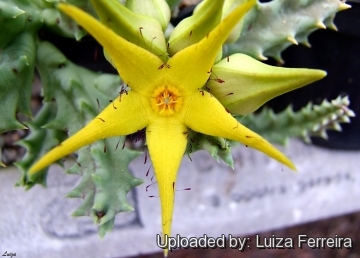 Orbea lutea Photo by: Luiza Ferreira
Orbea lutea Photo by: Luiza Ferreira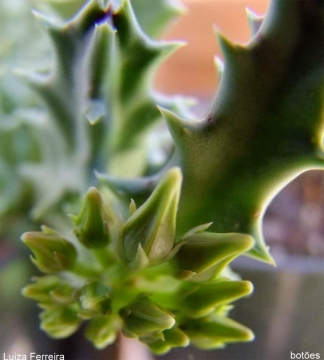 Orbea lutea Photo by: Luiza Ferreira
Orbea lutea Photo by: Luiza Ferreira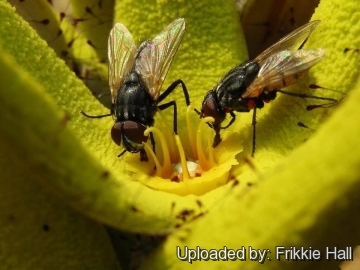 Orbea lutea Photo by: Frikkie Hall
Orbea lutea Photo by: Frikkie Hall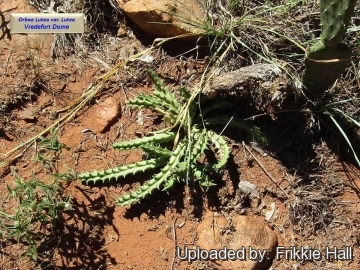 Growing habit at Vredefort dome, Free State, South Africa. Photo by: Frikkie Hall
Growing habit at Vredefort dome, Free State, South Africa. Photo by: Frikkie Hall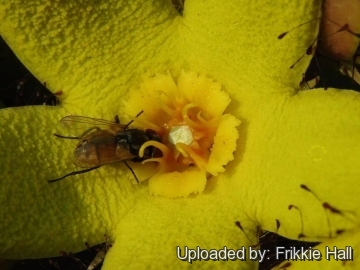 Orbea lutea Photo by: Frikkie Hall
Orbea lutea Photo by: Frikkie Hall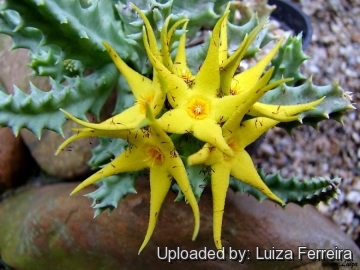 Orbea lutea Photo by: Luiza Ferreira
Orbea lutea Photo by: Luiza Ferreira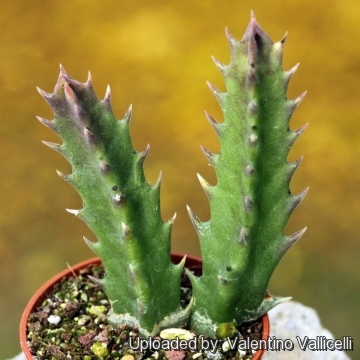 Orbea lutea Photo by: Valentino Vallicelli
Orbea lutea Photo by: Valentino VallicelliCultivation and Propagation: Orbea luteaSN|30484]]SN|30484]] is a very unusual xerophytic plant, remarkably easy in cultivation and it will grow in almost any type of soil. Orbea luteaSN|30484]]SN|30484]] grows very easily from stem cuttings planted directly in the desired spot in the garden.
Growth rate: It is a somewhat slow growing Stapeliad that will make large clumps given the best conditions. Most plants will offset readily, and clumps can be produced in a few years.
Soils: It likes very porous mineral cactus mix soil, pH 7,5 to 8,5 (mildly alkaline), but can become too elongated if compost is too rich.
Repotting: This plant needs plenty of space for its roots, repotting should be done every other year or when the it has outgrown its pot. Use pot with good drainage.
Watering: It needs regular watering, especially during the hottest summer days; provide also some light watering if the green house temperatures in winter are elevated. Either excessive or very scarce watering can induce rot.
Fertilization: Feed with a high potassium fertilizer in summer.
Frost Tolerance: For safe cultivation winter temperatures must be kept over 10° C, but it can withstand winter night-time temperatures down to about 5°(or less) Celsius for short period. Freezing temperatures are often fatal. In the rest period no high atmospheric humidity!!
Sun Exposure: Best for half-shade but grow well in full sun and full shade too. Tends to bronze in strong light, which encourages flowering, but is likely to suffer from sun scorch or stunted growth if over exposed to direct sunlight during the hottest part of the day in summer.
Diseases: Rot is only a minor problem with Orbea if the plants are watered and “aired” correctly. If they are not, fungicides won't help all that much.
Uses: It is an excellent plant for container growing. Clustering, great for a hanging display. Stems may possibly become purple and limp in winter, but revitalize in early spring. It always looks good and stays small. It look fine in a cold greenhouse and frame or outdoor in a rockery.
Propagation: Seeds and cuttings. Cuttings will root only in hot weather. Cuttings must be kept very dry to root. Seeds germinate readily if they are sown when fresh.
Your Photos

by Luiza Ferreira




















